Jamestown, Virginia
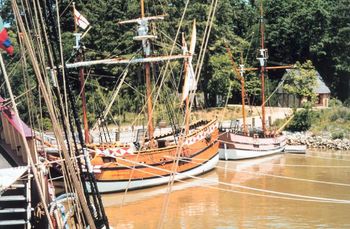
Jamestown, located on Jamestown Island in the Virginia Colony, was founded on May 14, 1607. It is the first permanent English settlement in what is now the United States of America, following several earlier failed attempts, including the Lost Colony of Roanoke. It was founded by the London Company (later to become the Virginia Company), headquartered in England. Within a year of Jamestown's foundation, the Virginia Company brought Polish and Dutch colonists to help improve the settlement. Located in James City County when it was formed in 1634 as one of the original eight shires of Virginia, Jamestown was the capital of the Colony for 83 years, from 1616 until 1699.[3] At that time, the capital was relocated to Middle Plantation, about 8 miles (13 km) distant.[4] (That small community, which had also become home to the new College of William and Mary in 1693, was renamed Williamsburg in 1699). The London Company's second settlement, Bermuda, claims the oldest town in the English New World, as St. George's, Bermuda was officially established (as New London) in 1612, where James Fort, in Virginia, is said not to have been converted into Jamestown until 1619. Jamestown ceased to exist as a settlement after the transfer of Virginia's capital to Williamsburg in 1699, existing, today, only as archaeological remains, whereas St. George's has continued in use throughout.[5]
Jamestown is one of three locations comprising the Historic Triangle of Colonial Virginia: Jamestown, Yorktown, and Williamsburg. Jamestown offers two areas to visit. Historic Jamestowne,[6] on Jamestown Island, is a cooperative effort by Jamestown National Historic Site, a part of Colonial National Historical Park, which is a unit of the National Park Service, and the Association for the Preservation of Virginia Antiquities. The other attraction is known as Jamestown Settlement, and located 1.25 miles (2.01 km) from the historic location of the colony. It is a Living History interpretive site operated by the Jamestown Yorktown Foundation in conjunction with the Commonwealth of Virginia and was established for the sesquarcentennial—350th anniversary—celebrations of Jamestown in 1957.
Nearby, the Jamestown-Scotland Ferry[7] service provides a link across the navigable portion of the James River for vehicles and offers passengers a view of Jamestown Island from the river, which is perhaps not greatly different from what the first colonists saw 400 years earlier. Traveling 11 miles (18 km) East down the National Park Service's scenic Colonial Parkway visitors can tour Colonial Williamsburg operated by the Colonial Williamsburg Foundation, site of the second capitol of Virginia. Continuing another 13 miles (21 km) East down the Colonial Parkway brings visitors to Yorktown, with another two areas to visit. Yorktown Battlefield also a part of Colonial National Historical Park, is operated by the National Park Service and is the site of the actual Battle of Yorktown. Located approximately 1-mile (1.6 km) from the battlefield, the Yorktown Victory Center is another living history interpretive site operated by the Jamestown Yorktown Foundation.
Settlement (1607–1705)
During the 16th and 17th centuries, various European countries were competing to establish colonies in the portion of the "New World" presently known as North America. One of the English attempts, a competitive effort by two proprietary arms of the Virginia Company, resulted in the first permanent English settlement at Jamestown in 1607.
Jamestown, which was originally also called "James Towne" or "Jamestowne", is located on the James River in what is currently James City County in the Commonwealth of Virginia. The site is about 40 miles (62 km) inland from the Atlantic Ocean and the entrance to the Chesapeake Bay and about 45 miles (70 km) downstream and southeast of the current state capital city of Richmond. Both the river and the settlement were named after King James I of England, who was on the throne at the time, granted the private proprietorship to the Virginia Company of London's enterprise.
The location at Jamestown Island was selected primarily because it offered a favorable strategic defensive position against other European forces which might approach by water. Another reason was because it was not inhabited by the local Virginia Indians.[8] However, the colonists soon discovered that the swampy and isolated site was plagued by mosquitoes and tidal river water unsuitable for drinking, and offered limited opportunities for hunting and little space for farming.[9]
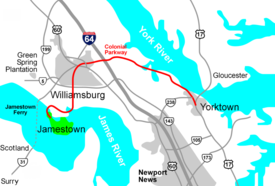
Despite the leadership of John Smith, chaplain Robert Hunt and others, starvation, hostile relations with the natives, and lack of profitable exports all threatened the survival of the Colony in the early years as the settlers and the Virginia Company of London each struggled. Polish and Dutch craftsmen were brought to help the colony in 1608.[2]
Colonist John Rolfe introduced a strain of tobacco which was successfully exported in 1612, and the financial outlook for the colony soon became much more favorable as colonists developed a profitable tobacco monoculture. Two years later, Rolfe married the young Indian woman Pocahontas, daughter of Wahunsenacawh, Chief of the Powhatan Confederacy, and a period of relative peace with the Natives followed. In 1616, the Rolfes made a public relations trip to England, where Pocahontas was received as visiting royalty. Changes by the Virginia Company which became effective in 1619 attracted additional investments, also sowing the first seeds of democracy in the process with a locally-elected body which became the House of Burgesses, the first such representative legislative body in the New World.
Throughout the 17th century, Jamestown was the capital of the Virginia Colony. Several times during emergencies, the seat of government for the colony was shifted temporarily to nearby Middle Plantation, a fortified location on the high ridge approximately equidistant from the James and York Rivers on the Virginia Peninsula. Shortly after the Colony was finally granted a long-desired charter and established the new College of William and Mary at Middle Plantation, the capital of the Colony was permanently relocated nearby. In 1699, the new capital town was renamed Williamsburg, in honor of the current English king, William III.
After the capital was relocated, Jamestown began a gradual loss of prominence and eventually reverted to a few large farms. It again became a significant point for control of the James River during the American Civil War (1861–1865), and then slid back into seeming oblivion. Even the Jamestown Exposition of 1907 was held elsewhere, at a more accessible location at Sewell's Point, on Hampton Roads near Norfolk.

Beginning in 1893, 22.5 acres (91,000 m2) of the Jamestown site were acquired by the Association for the Preservation of Virginia Antiquities. A crucial sea wall was built in 1900 to protect the shoreline near the site of James Fort from further erosion. In the 1930s, the Colonial National Historical Park was established to protect and administer Jamestown, which was designated a National Historic Site. The U.S. National Park Service acquired the remaining 1,500 acres (6.1 km2) of Jamestown Island through eminent domain in 1934.
For the 350th anniversary in 1957, Jamestown itself was the site of renewed interest and a huge celebration. The National Park Service provided new access with the completion of the Colonial Parkway which led to Williamsburg, home of the restored capital of Colonial Williamsburg, and then on to Yorktown, the other two portions of Colonial Virginia's Historic Triangle. Major projects such as the Jamestown Festival Park were developed by non-profit, state and federal agencies. Queen Elizabeth II of Great Britain and Prince Philip attended. The 1957 event was a great success. Tourism became continuous with attractions regularly updated and enhanced.
The two major attractions at Jamestown are separate, but complementary to each other. The state-sponsored Jamestown Settlement near the entrance to Jamestown Island includes a recreated English Fort and Native American Village, extensive indoor and outdoor displays, and features the three popular replica ships. On Jamestown Island itself, the National Park Service operates Historic Jamestowne. Over a million artifacts have been recovered by the Jamestown Rediscovery project with ongoing archaeological work, including a number of exciting recent discoveries.
Early in the 21st century, in preparation for the Jamestown 2007 event commemorating America's 400th Anniversary, new accommodations, transportation facilities and attractions were planned. The celebration began in the Spring of 2006 with the sailing of a new replica Godspeed to six major east coast U.S. cities, where several hundred thousand people viewed it. Queen Elizabeth II and Prince Phillip joined America's festivities on an official state visit to Jamestown in May, 2007.
18th Century
Due to the movement of the capital to Williamsburg, the old town of Jamestown began to slowly disappear from view. Those who lived in the general area attended services at Jamestown's church until the 1750s, when it was abandoned. By the mid-18th century, the land was heavily cultivated, primarily by the Travis and Ambler families. During the American Revolutionary War, although the Battle of Green Spring was fought nearby at the site of former Governor Berkeley's plantation, Jamestown was apparently inconsequential.
19th Century
1807: Bicentennial
The bicentennial of Jamestown on May 13–15, 1807 is said to have been a dignified celebration, commonly called the Grand National Jubilee. Over 3,000 people attended the event, many arriving on vessels which anchored in the river near the island.
Students of the College of William and Mary gave orations. An old barn on the island was used as a temporary theater, where a company of players from Norfolk performed. Attending were many dignitaries, politicians, and historians.
May 13 was the opening day of the festival, which began with a procession which marched to the graveyard of the old church, where the attending bishop delivered the prayer. The procession then moved to the Travis mansion, where the celebrants dined and danced in the mansion that evening. The Bicentennial celebration concluded on May 14 with a dinner and toast at the Raleigh Tavern in Williamsburg.
In 1831, David Bullock purchased Jamestown from Travis and Ambler families.
1857: 250th Anniversary
In 1857, the Jamestown Society organized a celebration marking the 250th anniversary of Jamestown's founding. According to the Richmond Enquirer, the site for the celebration was on 10 acres (40,000 m2) on the spot where some of the colonists' houses were originally built. However, it is also speculated that the celebration was moved further east on the island closer to the Travis grave site, in order to avoid damaging Major William Allen's corn fields.
The attendance was estimated at between 6 and 8 thousand people. Sixteen large steam ships anchored offshore in the James River and were gaily decorated with streamers. Former US President John Tyler of nearby Sherwood Forest Plantation gave a 2½ hour speech, and there were military displays, a grand ball and fireworks.[10]
1861–1865: American Civil War
During the American Civil War, in 1861, Confederate William Allen, who owned the Jamestown Island, occupied Jamestown with troops he raised at his own expense with the intention of blockading the James River and Richmond from the Union Navy. He was soon joined by Lieutenant Catesby ap Roger Jones who directed the building of batteries and conducted ordinance and armor tests for the first Confederate ironclad warship CSS Virginia which was under construction at the Gosport Naval Shipyard in Portsmouth in late 1861 and early 1862. Jamestown had a force of 1200 men which was augmented in early 1862 by an artillery battalion.
During the Peninsula Campaign which began later that spring, Union forces under General George B. McClellan moved up the Peninsula from Fort Monroe to attempt to capture the Confederate capital of Richmond. The Union forces captured Yorktown in April 1862, and the Battle of Williamsburg was fought the following month. With these developments, Jamestown and the lower James River were abandoned by the Confederates, and the Virginia was blown up off Craney Island on Hampton Roads to avoid capture. Some of the forces from Jamestown and the crew of the Virginia shifted to Drewry's Bluff, a fortified and strategic position located high above the river about 8 miles (13 km) below Richmond. There, they successfully blocked the Union Navy from reaching the Confederate capital.
Once in Federal hands, Jamestown became a meeting place for runaway slaves who burned the Ambler house, an eighteenth century plantation which along with the old church were the few remaining signs of Jamestown. When Allen sent men to assess damage in late 1862, they were killed by the former slaves. Following the surrender at Appomattox Courthouse, the oath of allegiance was administered to former Confederate soldiers at Jamestown.
Post-bellum
In the years after the Civil War, Jamestown became quiet and peaceful once again. In 1892, Jamestown was purchased by Mr. and Mrs. Edward Barney. The following year, the Barneys donated 22½ acres of land, including the 1639 church tower, to the Association for the Preservation of Virginia Antiquities (now APVA Preservation Virginia). By this time, erosion from the river had eaten away the island's western shore; visitors began to conclude that the site of James Fort lay completely underwater. With federal assistance, a sea wall was constructed in 1900 to protect the area from further erosion. The archaeological remains of the original 1607 fort, which had been protected by the sea wall, were discovered in 1994. (See Jamestown Rediscovery section below)
20th Century
The 100th anniversary of the Surrender at Yorktown in 1781 had generated a new interest in the historical significance of the colonial sites of the Peninsula. Williamsburg, a sleepy but populated town of shops and homes, was still celebrating Civil War events. However, as the new century dawned, thoughts turned to the upcoming 300th anniversary of the founding of Jamestown. The Association for the Preservation of Virginia Antiquities (APVA) started the movement in 1900 by calling for a celebration honoring the establishment of the first permanent English colony in the New World at Jamestown to be held on the 300th anniversary in 1907.
1907: Jamestown Exposition
As a celebration was planned, virtually no one thought that the actual isolated and long-abandoned original site of Jamestown would be suitable for a major event because Jamestown Island had no facilities for large crowds. The original fort housing the Jamestown settlers was believed to have been long ago swallowed by the James River.
Also, the general area in James City County near Jamestown was also considered unsuitable, as it was not very accessible in the day of rail travel before automobiles were common.
As the tercentennial of the 1607 Founding of the Jamestown neared, around 1904, despite an assumption in some quarters that Richmond would be a logical location, leaders in Norfolk, Virginia began a campaign to have a celebration held there. The decision was made to locate the international exposition on a mile-long frontage at Sewell's Point near the mouth of Hampton Roads. This was about 30 miles (48 km) downstream from Jamestown in a rural section of Norfolk County. It was a site which could become accessible by both long-distance passenger railroads and local streetcar service, with considerable frontage on the harbor of Hampton Roads. This latter feature proved ideal for the naval delegations which came from points all around the world.
The Jamestown Exposition of 1907 was one of the many world's fairs and expositions that were popular in the early part of the 20th century. It was from April 26, 1907 to December 1, 1907. Attendees included US President Theodore Roosevelt, Kaiser Wilhelm of Germany, the Prince of Sweden, Mark Twain, Henry H. Rogers, and dozens of other dignitaries and famous persons. A major naval review featuring the United State's Great White Fleet was a key feature. U.S. Military officials and leaders were impressed by the location, and the Exposition site later formed the first portion of the large U.S. Naval Station Norfolk in 1918 during World War I.
See also article Jamestown Exposition
1932: Statehouse Ruins, Jamestowne Society
In 1932, George Craghead Gregory of Richmond was credited with discovering the foundation of the first brick statehouse (capitol) building circa 1646 at Jamestown on the land owned by the APVA.[11]
About four years later, Gregory, who was active with the Virginia Historical Society, founded the Jamestowne Society for descendants of stockholders in the Virginia Company of London and the descendants of those who owned land or who had domiciles in Jamestown or on Jamestown Island prior to the year 1700. Since its founding, the Society has helped with genealogical records and expanded into dozens of branches, called "Companies." (In the Jamestowne Society, "Companies" are similar to chapters in most lineage societies). Membership in Companies is elective, while membership in the national Society is acquired at the time a member joins. In 1958, the Jamestowns Society was formally organized as a non-profit corporation under section 501(c)(3) of the Internal Revenue Code (1954, as amended). It frequently holds meetings and events.[12]
1934: National Park Service Acquires The Rest Of Jamestown Island
Colonial National Monument was authorized by the U.S. Congress on July 3, 1930. It was established on December 30, 1930. On June 5, 1936, it was re-designated a national historical park, and became known as Colonial National Historical Park.
In 1934, the National Park Service obtained the remaining 1500 acre (6.1 km²) portion of Jamestown Island which had been under private ownership by the Vermillion family. The National Park Service partnered with the APVA to preserve the area and present it to visitors in an educational manner.
1957: Jamestown's 350th Anniversary
With America's increased access to automobiles, and with improved roads and transportation, it was feasible for the 350th anniversary celebration to be held at Jamestown itself in 1957.
Although erosion had cut off the land bridge between Jamestown Island and the mainland, the isthmus was restored and new access provided by the completion of the National Park Service's Colonial Parkway which led to Williamsburg and Yorktown, the other two portions of Colonial Virginia's Historic Triangle. There were also improvements of state highways. The north landing for the popular Jamestown Ferry and a portion of State Route 31 were relocated.
Major projects such were developed by non-profit, state and federal agencies. Jamestown Festival Park was established by the Commonwealth of Virginia adjacent to the entrance to Jamestown Island. Full-sized replicas of the three ships that brought the colonists, the Susan Constant, the Godspeed, and the Discovery were constructed at a shipyard in Portsmouth, Virginia and placed on display at a new dock at Jamestown, where the largest, the Susan Constant, could be boarded by visitors.
On Jamestown Island, the reconstructed Jamestown Glasshouse, the Memorial Cross and the visitors center were completed and dedicated. A loop road was built around the island.
Special events included army and navy reviews, air force fly-overs, ship and aircraft christenings and even an outdoor drama at Cape Henry, site of the first landing of the settlers. This celebration continued from April 1 to November 30 with over a million participants, including dignitaries and politicians such as the British Ambassador and U.S. Vice President Richard Nixon.
The highlight for many of the nearly 25,000 at the Festival Park on October 16, 1957 was the visit and speech of Queen Elizabeth II of the United Kingdom and her consort, Prince Philip. Queen Elizabeth II loaned a copy of the Magna Carta for the exhibition. It was her first visit to the United States since assuming the throne.
The 1957 Jamestown Festival was so successful that tourists still kept coming long after the official event was completed. Jamestown became a permanent attraction of the Historic Triangle, and has been visited by families, school groups, tours, and thousands of other people continuously ever since.
1994: Jamestown Rediscovery
Starting in 1994, a major archaeological campaign at Jamestown known as the Jamestown Rediscovery project has been conducted by the Association for the Preservation of Virginia Antiquities (now APVA Preservation Virginia) in preparation for the quadricentennial of Jamestown's founding. The original goal of the archaeological campaign was to locate archaeological remains of "the first years of settlement at Jamestown, especially of the earliest fortified town; [and the] the subsequent growth and development of the town".[13]
Early on, the project discovered early colonial artifacts. This was something of a surprise to some historians as it had been widely thought that the original site had been entirely lost due to erosion by the James River. Many others suspected that at least portions of the fort site remained and subsequent excavations have shown that only one corner of the first triangular fort (which contained the original settlement) turned out to have been destroyed. The sea wall built in 1900 to limit the erosion turned out to be a rich investment in the past and the future.
Since it began, the extended archaeological campaign has made many more discoveries including retrieving hundreds of thousands of artifacts, a large fraction of them from the first few years of the settlement's history. In addition, it has uncovered much of the fort, the remains of several houses and wells, a palisade wall line attached to the fort and the graves of several of the early settlers.
21st Century
Historic Jamestowne
Historic Jamestowne, located at the downtown original site of Jamestown in the Virginia Colony, is administered by APVA Preservation Virginia and the National Park Service. The central 22½ acres of land were donated to the Association for the Preservation of Virginia Antiquities (now APVA Preservation Virginia) in 1893 and the remaining 1,500 acres (6.1 km2) were acquired by the National Park Service in 1934 and are now part of the Colonial National Historical Park. The two organizations have worked together since 1941 to preserve the site of the first permanent English settlement in North America and to interpret its history for visitors.
Today, visitors to Historic Jamestowne can view the site of the original 1607 James Fort, the 17th century church tower and the site of the 17th century town, as well as tour an archaeological museum called the Archaearium and view many of the hundreds of thousands of artifacts found by Jamestown Rediscovery. They also may participate in living history and ranger tours.
Visitors can also often observe archaeologists from the Jamestown Rediscovery Project at work, as archaeological work at the site continues and is greatly expanding knowledge of what happened at Jamestown in its earliest days.
Among the discoveries, a grave site with indications of an important figure was located. Some theorize the remains to be that of Captain Bartholomew Gosnold[14] though others have claimed it to be the remains of Thomas West, 3rd Baron De La War. It had long been thought that Baron De La War, who died en route back to the colony from England on his second trip, had been buried elsewhere but some recent research concluded that his body was in fact brought to Jamestown for burial.[15]
The archaeological work and studies are ongoing as of 2009,[16] New discoveries are frequently reported in the local newspaper, the Virginia Gazette based in nearby Williamsburg, and by other news media, often worldwide.[17]
Jamestown Settlement
Although the 1957 celebration is long past, many of the attractions adjacent to the APVA-NPS site were created as part of the what was known as Jamestown Festival Park, largely sponsored by the Commonwealth.
In 1987 John Otho Marsh, Jr., the Secretary of the Army of the United States of America planted an oak tree at Runnymede England commemorating and linking the bicentenary of the Constitution with the establishment of the Jamestown settlement
Jamestown 2007
Jamestown 2007 was an event commemorating the 400th anniversary (quadricentennial) of the founding of Jamestown.
Several events are being promoted under the banner of America's 400th Anniversary and promoted by the Jamestown 2007 Commission. America's 400th Anniversary is commemorating the quadricentennial of the founding of the Jamestown Settlement with 18 months of statewide, national and international festivities and events which began in April 2006 with a tour of the new replica Godspeed.
In January 2007, the Virginia General Assembly held a session at Jamestown, where a speech was given by then U.S. Vice-President Dick Cheney, and Virginia's Governor at the time Tim Kaine delivered the "State of the Commonwealth" speech.
Queen Elizabeth II of the United Kingdom and Prince Philip attended the main ceremonies in May 2007.
Some members of Virginia Indian[18] tribes did not attend the festivities, out of concern over what they perceive the settlement to represent for their people.[19][20]
Jamestown In Film
A highly fictionalized version of the Jamestown settlement is depicted in the animated Disney film Pocahontas (1995). Among other inaccuracies it is shown as being near mountains, when it was actually located on a coastal plain.
A feature length film, The New World (2006), directed by Terrence Malick, covers the story of Jamestown's colonization. Although the historical details are accurate in most ways, the plot focuses on a dramatized relationship between John Smith, played by Colin Farrell, and Pocahontas. Many scenes were filmed on-location along the James and Chickahominy Rivers and at Henricus Historical Park in Chesterfield County, Virginia.
Another feature length film, First Landing: The Voyage from England to Jamestown (2007) documents the 1607 landing of English colonists.
This article is copied from an article on Wikipedia® - the free encyclopedia created and edited by online user community. The text was not checked or edited by anyone on our staff. Although the vast majority of the Wikipedia® encyclopedia articles provide accurate and timely information please do not assume the accuracy of any particular article. This article is distributed under the terms of GNU Free Documentation License.
Thanks to The Free Dictionary
http://encyclopedia.thefreedictionary.com/p/Jamestown,%20Virginia


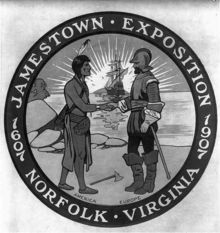
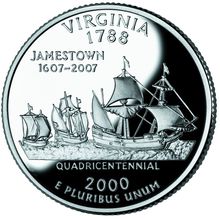
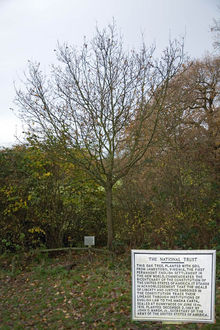

No comments:
Post a Comment